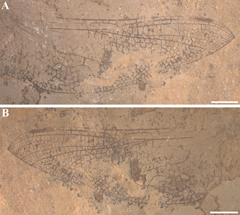Abstract
Several newly collected dragonfly wings from the Lower Cretaceous Naijiahe Formation (Kangjiawan locality, Tongxin County, Ningxia Hui Autonomous Region, NW China) have been identified as belonging to the widely distributed species Hemeroscopus baissicus, found in North China and South Korea at similar palaeolatitudes. This species shows potential for stratigraphic correlation. The findings suggest that the Shahai-Fuxin Formation (western Liaoning), Lushangfen-Xiazhuang Formation (western Beijing), Madongshan-Naijiahe Formation (Ningxia), and Zhonggou Formation (Jiuquan Basin) are likely of comparable ages.
References
Bechly G. 1996. Morphologische Untersuchungen am Flügelgeäder der rezenten Libellen und deren Sta mmgruppenvertreter (Insecta; Pterygota; Odonata), unter besonderer Berücksichtigung der Phylogenetischen Systematik und des Grundplanes der Odonata. Petalura 2: 1–402.
Chae Y.-U., Lim J. D., Kim C.-B., Kim K. S., Ha S. & Lim H. S. 2020. Detrital zircon U-Pb ages of the uppermost Jinju Formation in the Natural Monument No. 534 ‘Tracksite of Pterosaurs, Birds, and Dinosaurs in Hotandong, Jinju’, Korea. Journal of the Korean Earth Sciences Society 41(4): 367–680. https://doi.org/10.5467/JKESS.2020.41.4.367
Fleck G. & Nel A. 2003. Revision of the Mesozoic family Aeschnidiidae (Odonata: Anisoptera). Zoologica 153: 1–180.
Gao H. L., Zhang Y., Su Y. T., Shen L. W., Nie X. M. & Huang D. Y. 2024. Newly identified late early cretaceous volcanic rocks in the Beixiangshan area, Lower Yangtze River Belt, south china and its implications. Mesozoic 1(2): 159–172. https://doi.org/10.11646/mesozoic.1.2.8
Hong S. K. & Lee Y. I. 2012. Evaluation of atmospheric carbon dioxide concentrations during the Cretaceous. Earth and Planetary Science Letters 327–328, 23–28. https://doi.org/10.1016/j.epsl.2012.01.014
Hong Y. C. & Li Z. Y. 2004. A new Early Cretaceous family from Liupanshan, Ningxia China (Insecta, Trichoptera). Acta Zootaxonomica Sinica 29(2): 224–233.
Huang D. Y. & Lin Q. B. 2001. The Early Cretaceous hemeroscopid larval fossils from Beijing, China. Chinese Science Bulletin 46(17): 1477–1481. https://doi.org/10.1007/BF03187036
Huang D. Y., Wu H. & Dong F. B. 2009. The discover and preliminary study of fossil caddis case in China. Acta Palaeontologica Sinica 48(4): 646–653.
Huang J. D. & Ren D. 2008. Ephemeropsis trisetalis Eichwald might have been absent in the Jehol Biota from China. Geological Review 54(5): 602–609.
Liao H. Y., Shen Y. B. & Huang D. Y. 2014. The conchostracan biostratigraphy of the lower Cretaceous Lushangfeng Formation in Beijing. Acta Palaeontologica Sinica 53(4): 575–582. [in Chinese].
Lin Q. B, Nel A. & Huang D. Y. 2002. Phylogenetic analysis of the Mesozoic dragonfly family Liupanshaniidae (Insecta: Aeshnoptera: Odonata). Cretaceous Research 23: 439–444.
Makarkin V. N., Yang Q., Peng Y. & Ren D. 2012. A comparative overview of the neuropteran assemblage of the Lower Cretaceous Yixian Formation (China), with description of a new genus of Psychopsidae (Insecta: Neuroptera). Cretaceous Research 35: 57–68. https://doi.org/10.1016/j.cretres.2011.11.013
Nam K. S. & Kim J. H. 2016. Reconstruction and paleoecological implications of dragonfly Hemeroscopus baissicus Pritykina, 1977 (Hemeroscopidae) from the Lower Cretaceous Jinju Formation in the Jinju Area, Korea. Journal of the Geological Society of Korea 52(2): 105–112. https://doi.org/10.14770/jgsk.2016.52.2.105
Nel A., Martínez-Delclòs X., Paicheler J. C. & Henrotay M. 1993. Les “Anisozygoptera” fossiles. Phylogénie et classification (Odonata). Martinia Hors Série 3: 1–311.
Paik I. S., Lee Y. I., Kim H. J. & Huh M. 2012. Time, space and structure on the Korea Cretaceous Dinosaur Coast: Cretaceous stratigraphy, geochronology and paleoenvironment. Ichnos 19: 6–16. https://doi.org/10.1080/10420940.2012.660404
Pritykina L. N. 1977. Novyye strekozy iz nizhnemelovykh otlozheniy Zabaykal’ya i Mongolii [New dragonflies from Lower Cretaceous deposits of Transbaïkalia and Mongolia]. In: Fauna, flora i biostratigrafiya mezozoya i kaynozoya Mongolii [Fauna, Flora, and Biostratigraphy of the Mesozoic and Cenozoic of Mongolia]. Trudy Sovmestnaya Sovetsko-Mongol’skaya Paleontologicheskaya Ekspeditsiya 4: 81–96. [in Russian].
Ren D., Liu J. Y. & Cheng X. D. 2003. A new hemeroscopid dragonfly from the Lower Cretaceous of northeast China (Odonata: Hemeroscopidae). Acta Entomologica Sinica 46(5): 622–628.
Ren D., Lu L. W., Guo Z. G. & Ji S. A. 1995. Faunae and stratigraphy of the Jurassice Cretaceous in Beijing and adjacent areas. Seismic Publishing House, Beijing, 222 pp. [in Chinese with English summary].
Riek E. F. & Kukalová-Peck J. 1984. A new interpretation of dragonfly wing venation based upon early Carboniferous fossils from Argentina (Insecta: Odonatoidea) and basic characters states in pterygote wings. Canadian Journal of Zoology 62: 1150–1166. https://doi.org/10.1139/z84-166
Sur K. H., Lee Y. I. & Hisada K. 2002. Diagenesis of the lower Cretaceous Kanmon Group sandsstones, SW Japan. Journal of Asian Earth Sciences 20: 921–935. https://doi.org/10.1016/S1367-9120(01)00086-4
Ueda K., Kim T. & Aoki T. 2005. A new record of Early Cretaceous fossil dragonfly from Korea. Bulletin of the Kitakyushu Museum of Natural History and Human History (A) 3: 145–152.
Wang H. M. & Lu Y. J. 2012. Sporopollen assemblage characteristics and discussion of Ancient vegetation, palaeoclimate at Cretaceous Naijiahe Group in south Huashan of Haiyuan County in Ningxia. Science and Technology Innovation Herald 29: 238–239.
Xi D. P., Wan X. Q., Li G. B. & Li G. 2019. Cretaceous integrative stratigraphy and timescale of China. Science in China, Earth Science 62(1): 256–286. https://doi.org/10.1007/s11430-017-9262-y
Zhang H. C. 1997. Early Cretaceous insects from the Dalazi Formation of the Zhixin Basin, Jilin Province, China. Palaeoworld 7: 75–103.
Zheng D. R., Zhang H. C., Zhang Q., Li S., Wang H., Fang Y. N., Liu Q., Jarzembowski E. A., Yan E. Y. & Wang B. 2015. The discovery of an Early Cretaceous dragonfly Hemeroscopus baissicus Pritykina, 1977 (Hemeroscopidae) in Jiuquan, Northwest China, and its stratigraphic implication. Cretaceous Research 52: 316–322. https://doi.org/10.1016/j.cretres.2014.02.020


